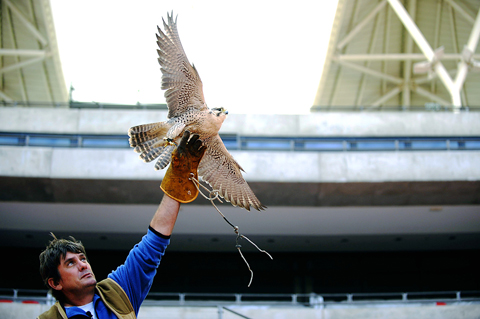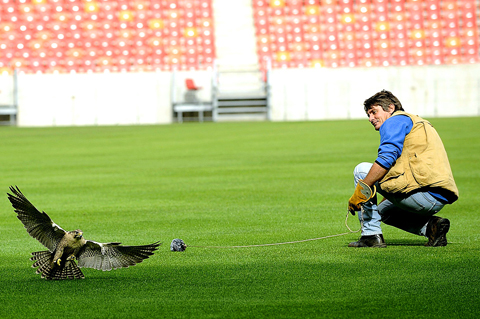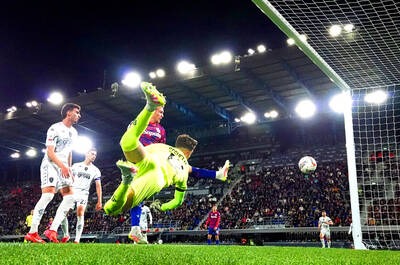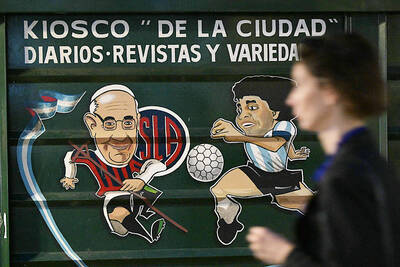A South African World Cup stadium has turned to birds of prey to chase out rogue pigeons and rats in an anti-pest strategy that favors raptors above the pitch instead of poisons.
The new 46,000-seat stadium in coastal Port Elizabeth sports several bird and bat boxes under the outer eaves of its striking petal-shaped roof to draw aerial hunters.
“We’ve gone completely poison free. This is the only stadium with a program like this in place as a pest deterrent,” stadium manager Rob Hichens said.

PHOTO: AFP
The strategy was designed as a harmonious system — the wild raptors hunt and chase away feral pigeons, eliminating the notoriously slovenly birds’ nests and droppings which attract rats.
“Pigeons are extremely messy. The whole of town is riddled with them. I did a feral pigeon count in town and we’ve got over 10,000 birds,” said Arnold Slabbert of the Urban Raptor Project, who drew up the pest strategy.
The birds carry lice and diseases in their feces which damage the seats, while rats eat the droppings and raid the nests for eggs and chicks, he said.

PHOTO: AFP
“Immediately, you are allowing a big pigeon problem to develop, you are causing a rat problem to start as well. You don’t want pigeons in a stadium, end of story,” he said.
The raptors can be seen soaring above the 2 billion rand (US$264 million) stadium, which overlooks a lake near the city’s central business district, while wagtails are spotted feeding off insects on the pitch.
“At the moment, three African peregrine falcons live in the stadium. They hunt quite extensively,” he said. “They’re extremely effective at controlling the pigeon population. The pigeons don’t come near the stadium, they just stay away. It’s an amazing deterrent.”
Bat boxes were also erected in trees and under the outer stadium roof for indigenous bats — which can eat 132 mosquitos an hour — drawn by insects attracted by the stadium’s lights and its lake setting.
Plans are also afoot to introduce indigenous grass-eating rats in the surrounding marshy areas to provide food for hunting rock kestrels to draw them to the stadium, which has no rat problem, Slabbert said.
“I look at an integrated control of all pest species. I’m creating a complete little ecosystem here,” he said.
A hand-reared larger falcon is brought in to chase away crows, which pick on electrical wires and whose roosts can number about 100 birds. A would-be red wing starling residence has also been chased out of the stadium.
Slabbert was approached to identify potential bird problems during the three years it took to build the stadium and he has set up similar projects in the area.
“It’s the only World Cup stadium that does this and it’s the only World Cup stadium that definitely doesn’t have a bird problem,” Slabbert said.

Bologna on Thursday advanced past Empoli to reach their first Coppa Italia final in more than half a century. Thijs Dallinga’s 87th-minute header earned Bologna a 2-1 win and his side advanced 5-1 on aggregate. Giovanni Fabbian opened the scoring for Bologna with a header seven minutes in. Then Viktor Kovalenko equalized for Empoli in the 30th minute by turning in a rebound to finish off a counterattack. Bologna won the first leg 3-0. In the May 14 final in Rome, Bologna are to face AC Milan, who eliminated city rivals Inter 4-1 on aggregate following a 3-0 win on Wednesday. Bologna last reached the

If the Wild finally break through and win their first playoff series in a decade, Minnesota’s top line likely will be the reason. They were all over the Golden Knights through the first two games of their NHL Western Conference quarter-finals series, which was 1-1 going back to Minnesota for Game 3 today. The Wild tied the series with a 5-2 win on Tuesday. Matt Boldy had three goals and an assist in the first two games, while Kirill Kaprizov produced two goals and three assists. Joel Eriksson Ek, who centers the line, has yet to get on the scoresheet. “I think the biggest

From a commemorative jersey to a stadium in his name, Argentine soccer organizers are planning a slew of tributes to their late “Captain” Pope Francis, eulogized as the ultimate team player. Tributes to the Argentine pontiff, a lifelong lover of the game, who died on Monday at the age of 88, have been peppered with soccer metaphors in his homeland. “Francisco. What a player,” the Argentine Football Federation (AFA) said, describing the first pope from Latin America and the southern hemisphere as a generational talent who “never hogged the ball” and who showed the world “the importance of having an Argentine captain,

Noelvi Marte on Sunday had seven RBIs and hit his first career grand slam with a drive off infielder Jorge Mateo, while Austin Wynn had a career-high six RBIs as the Cincinnati Reds scored their most runs in 26 years in a 24-2 rout of the Baltimore Orioles. Marte finished with five hits, including his eighth-inning homer off Mateo. Wynn hit a three-run homer in the ninth off catcher Gary Sanchez. Cincinnati scored its most runs since a 24-12 win against the Colorado Rockies on May 19, 1999, and finished with 25 hits. Baltimore allowed its most runs since a 30-3 loss to